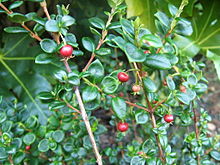Ugni
| Ugni | |
|---|---|

| |
| Ugni molinae | |
| Scientific classification | |
| Kingdom: | Plantae |
| Clade: | Tracheophytes |
| Clade: | Angiosperms |
| Clade: | Eudicots |
| Clade: | Rosids |
| Order: | Myrtales |
| Family: | Myrtaceae |
| Subfamily: | Myrtoideae |
| Tribe: | Myrteae |
| Genus: | Ugni Turcz. |
| Type species | |
| Ugni molinae | |
Ugni is a genus of plants of the myrtle family (Myrtaceae). Four species belong to this genus, all from western America.
Description[change | change source]
They are small evergreen shrubs. The leaves are simple, entire, opposite, elliptical; they are 1–2 cm long and 0.2-2.5 cm broad, dark green, and with a spicy scent if broken into many small pieces.[1]
The solitary flowers are usually hanging; they are 1–2 cm diameter with four or five white or pale pink petals and many short stamens. The fruit is a small red or purple berry, 1 cm in diameter, with many seeds.[1]
Name[change | change source]
The name comes from Uñi with which the Mapuches (native people from south-central Chile and southwestern Argentina) name the fruits of the best known species of the genus, Ugni molinae.
The genus was formerly often included in either Myrtus or Eugenia; it is distinguished from these two genera by the hanging flowers with stamens shorter than the petals.
The Russian botanist Nicolai Stepanowitsch Turczaninow created the genus Ugni in 1849.[2]
Where it grows[change | change source]
All species of this genus are found in western South and Central America, native from southern Mexico to central southern Chile and Argentina.
Species[change | change source]
There are four species in this genus:'[3][4]
- Ugni candollei (Barnéoud) O.Berg: Chile
- Ugni molinaeTurcz.: Chile and Argentina
- Ugni myricoides (Kunth) O.Berg: Southern Mexico, Central America to Bolivia, Venezuela and northern Brazil
- Ugni selkirkii (Hook. & Arn.) O.Berg: Endemic species of the Juan Fernández Islands, Chile
Uses[change | change source]
Ugni molinae is grown as an ornamental plant and for its edible fruits; these fruits are also used to make jams.[5]
References[change | change source]
- ↑ 1.0 1.1 Carmen Ulloa Ulloa & Peter Møller Jørgensen. "Ugni Turcz". Árboles y arbustos de los Andes del Ecuador (in Spanish). eFloras.org. Retrieved 24 July 2013.
- ↑ Nicolai Stepanowitsch Turczaninow (1848). "Bulletin de la Société impériale des naturalistes de Moscou, xxi, No. 1" (in Latin). p. 579. Retrieved 24 July 2013.
- ↑ Royal Botanic Gardens, Kew. "Ugni". World Checklist of Selected Plant Families. Retrieved 24 July 2013.
- ↑ "Search results - Ugni". The Plant List. Retrieved 24 July 2013.
- ↑ "Lost Crops of the Incas:". The National Academies Press. Retrieved 24 July 2013.
